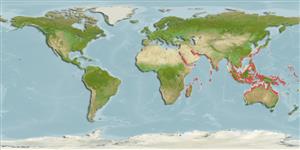>
Syngnathiformes (Pipefishes and seahorses) >
Syngnathidae (Pipefishes and seahorses) > Syngnathinae
Etymology: Acentronura: Greek, a = without + Greek, kentron = sting + Greek, oura = tail (Ref. 45335).
More on author: Günther.
Environment: milieu / climate zone / depth range / distribution range
Ökologie
seewasser riff-verbunden; tiefenbereich 1 - 20 m (Ref. 48635). Tropical
Indo-West Pacific: northern Red Sea and Mozambique to Torres Straits and Queensland, Australia. Also reported from Persian Gulf (Ref. 68964).
Size / Gewicht / Alter
Maturity: Lm ? range ? - ? cm
Max length : 6.3 cm TL Männchen/unbestimmt; (Ref. 4281)
Rückenflossenstacheln (insgesamt) : 0; Rückenflossenweichstrahlen (insgesamt) : 16 - 17; Afterflossenstacheln: 0; Afterflossenweichstrahlen: 4. Brown in color, dermal flaps blackish. Caudal absent in sub adults and adults. Females are slender and pipefish-like, but larger males are more seahorse-like (Ref. 48635).
Typically found on small and sparse seagrass or algae that grow adjacent to reefs at shallow to moderate depths. Usually found in pairs (Ref. 48635). Ovoviviparous (Ref. 205). The male carries the eggs in a brood pouch which is found under the tail (Ref. 205).
Life cycle and mating behavior
Maturities | Fortpflanzung | Spawnings | Egg(s) | Fecundities | Larven
Male carries the eggs in a brood pouch (Ref. 205).
Dawson, C.E., 1986. Syngnathidae. p. 445-458. In M.M. Smith and P.C. Heemstra (eds.) Smiths' sea fishes. Springer-Verlag, Berlin. (Ref. 4281)
IUCN Rote Liste Status (Ref. 130435)
Bedrohung für Menschen
Harmless
Nutzung durch Menschen
Tools
Zusatzinformationen
Download XML
Internet Quellen
Estimates based on models
Preferred temperature (Ref.
123201): 24.9 - 29.3, mean 28.5 °C (based on 3288 cells).
Phylogenetic diversity index (Ref.
82804): PD
50 = 0.6250 [Uniqueness, from 0.5 = low to 2.0 = high].
Bayesian length-weight: a=0.00389 (0.00180 - 0.00842), b=3.12 (2.94 - 3.30), in cm total length, based on all LWR estimates for this body shape (Ref.
93245).
Trophic level (Ref.
69278): 3.2 ±0.5 se; based on size and trophs of closest relatives
Widerstandsfähigkeit (Ref.
120179): hoch, Verdopplung der Population dauert weniger als 15 Monate. (Preliminary K or Fecundity.).
Fishing Vulnerability (Ref.
59153): Low vulnerability (10 of 100).
